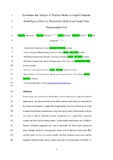| dc.contributor.author | Thornton, Eoghan | |
| dc.contributor.author | Ghabezi, Pouyan | |
| dc.contributor.author | Strain, Findhan | |
| dc.contributor.author | Harrison, Noel M. | |
| dc.date.accessioned | 2022-10-17T11:11:40Z | |
| dc.date.issued | 2022-04-11 | |
| dc.identifier.citation | Thornton, Eoghan, Ghabezi, Pouyan, Ralph, Calvin, Strain, Findhan, & Harrison, Noel M. (2022). Evaluation and Analysis of Fracture Modes in Single Composite Basalt/Epoxy Fibres by Photoelastic Method and Single Fibre Fragmentation Test. Fibers and Polymers, 23(5), 1396-1409. doi:10.1007/s12221-022-4597-y | en_IE |
| dc.identifier.issn | 1875-0052 | |
| dc.identifier.uri | http://hdl.handle.net/10379/17422 | |
| dc.description.abstract | In this work, the suitability of basalt fibres for uni-directional composite material applications, and adhesion between the fibres and the matrix they are embedded in have been investigated. A single fibre fragmentation test was carried out on 13 µm diameter basalt fibres embedded in a dog-bone epoxy matrix. Photoelastic analysis was used to observe different fracture mechanisms in a single fibre composite sample and fibre breaks during testing. A theoretical model based on a Griffithâ s fracture mechanics approach was used to determine the fibre-matrix interfacial shear strength, which is a measurement of the level of adhesion between the fibre and the matrix. It was also used to predict the fibre fragment axial stress and the fragment interfacial shear stress, both as functions of axial position on the fibre. A finite element model was developed to simulate the fibre fracture process, and the redistribution of stresses in the fibre and the local region surrounding a fibre break. The developed experimental procedure was successful in that stress-induced birefringence was observed in the tested samples, as well as the characteristic shear stress light fringes that occur in the regions surrounding fibre fractures. Also, there were some similarities between the finite element model results and the theoretical predictions. The critical fibre length, lc was measured as 0.752 mm, whereas this value was calculated 0.6708 mm from finite element predicted interfacial shear stress distribution for fibre fragment. A combination of all three types of failure modes was recorded across the samples that were tested, while only a single failure mode was observed in the finite element model. According to the theoretical model, for a given set of parameters and constant stress with only the fibre length varying, the axial stress in the fibre reduces as the fibre gets smaller.In this work, the suitability of basalt fibres for uni-directional composite material applications, and adhesion between the fibres and the matrix they are embedded in have been investigated. A single fibre fragmentation test was carried out on 13 µm diameter basalt fibres embedded in a dog-bone epoxy matrix. Photoelastic analysis was used to observe different fracture mechanisms in a single fibre composite sample and fibre breaks during testing. A theoretical model based on a Griffithâ s fracture mechanics approach was used to determine the fibre-matrix interfacial shear strength, which is a measurement of the level of adhesion between the fibre and the matrix. It was also used to predict the fibre fragment axial stress and the fragment interfacial shear stress, both as functions of axial position on the fibre. A finite element model was developed to simulate the fibre fracture process, and the redistribution of stresses in the fibre and the local region surrounding a fibre break. The developed experimental procedure was successful in that stress-induced birefringence was observed in the tested samples, as well as the characteristic shear stress light fringes that occur in the regions surrounding fibre fractures. Also, there were some similarities between the finite element model results and the theoretical predictions. The critical fibre length, lc was measured as 0.752 mm, whereas this value was calculated 0.6708 mm from finite element predicted interfacial shear stress distribution for fibre fragment. A combination of all three types of failure modes was recorded across the samples that were tested, while only a single failure mode was observed in the finite element model. According to the theoretical model, for a given set of parameters and constant stress with only the fibre length varying, the axial stress in the fibre reduces as the fibre gets smaller. | en_IE |
| dc.format | application/pdf | en_IE |
| dc.language.iso | en | en_IE |
| dc.publisher | Springer | en_IE |
| dc.relation.ispartof | Fibers and Polymers | en |
| dc.rights | CC BY-NC-ND 3.0 IE | |
| dc.rights.uri | https://creativecommons.org/licenses/by-nc-nd/3.0/ie/ | |
| dc.subject | Basalt fibre | en_IE |
| dc.subject | Photoelastic | en_IE |
| dc.subject | Fracture mode | en_IE |
| dc.subject | Single fibre fragmentation test | en_IE |
| dc.subject | Finite element modeling | en_IE |
| dc.title | Evaluation and analysis of fracture modes in single composite basalt/epoxy fibres by photoelastic method and single fibre fragmentation test | en_IE |
| dc.type | Article | en_IE |
| dc.date.updated | 2022-10-17T09:02:40Z | |
| dc.identifier.doi | 10.1007/s12221-022-4597-y | |
| dc.local.publishedsource | https://doi.org/10.1007/s12221-022-4597-y | en_IE |
| dc.description.peer-reviewed | peer-reviewed | |
| dc.description.embargo | 2023-04-11 | |
| dc.internal.rssid | 29295819 | |
| dc.local.contact | Noel Harrison, Mechanical Engineering, College Of Engineering And Infor, Nui Galway, Galway. Email: noel.harrison@nuigalway.ie | |
| dc.local.copyrightchecked | Yes | |
| dc.local.version | ACCEPTED | |
| nui.item.downloads | 27 | |


